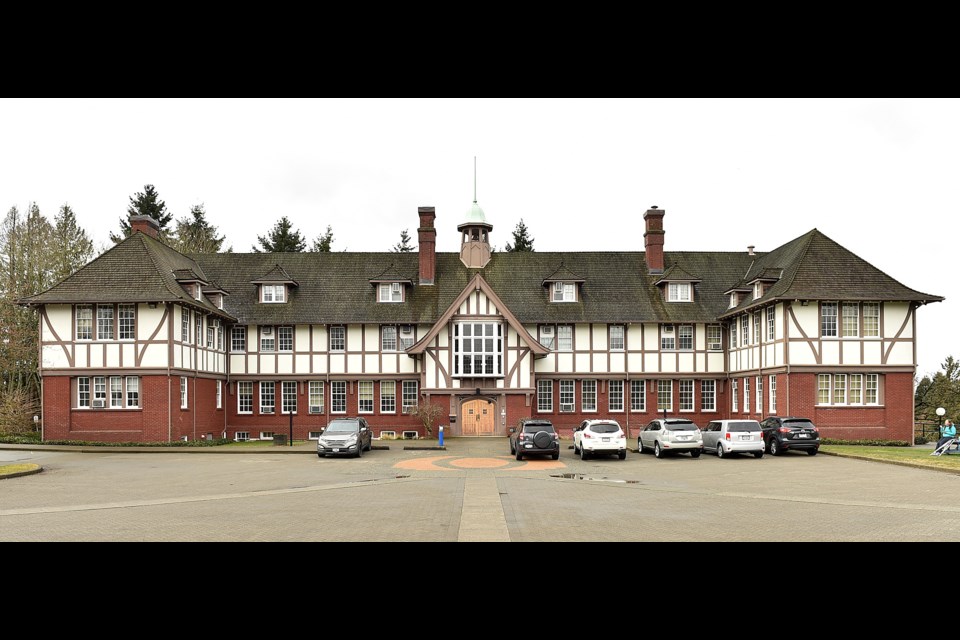Moving the historic Fairmont building from the Heather Lands to another site promises to be an enormous task, especially since a new site still needs to be found.
But thatтАЩs exactly whatтАЩs being recommended as three First Nations and Canada Lands Company prepare to redevelop the property, which sits between 33rd and 37th avenues at Heather Street, and was home to the RCMPтАЩs headquarters and operations centre until 2012.
In 2014, the Musqueam, Squamish and Tsleil-Waututh Nations and Canada Lands Company entered into a 50/50 joint venture for the ownership and redevelopment of the 21-acre site.
The three First Nations are known as MST Partners for the project.
Work on a policy statement to guide the redevelopment is underway and is expected to go to council for its consideration later this spring.
The first round of open houses last fall revealed three options for the redevelopment, including a request for the removal of the Fairmont building тАЬas a measure of Reconciliation.тАЭ
The preferred concept, outlined at open houses March 10 and 12, envisions a cultural centre where the Fairmont building is now located.
Although itтАЩs economically viable to retain and repurpose the building, тАЬit represents a difficult era for the First Nations people in Vancouver, when customs and culture was oppressed and the Nations peoples were shifted off their traditional lands,тАЭ according to the relocation proposal.
A new cultural centre, meanwhile, would showcase Indigenous-inspired architecture and provide a venue for sharing culture, traditions and values of the Musqueam, Squamish and Tsleil-Waututh peoples, as well as provide space for the local community.
Based on the proposal, if a new site cannot be found for the Fairmont building within a timeframe the City of ┬щ╢╣┤л├╜╙│╗нestimates to be in the three- to five-year range, it could be demolished.
Looking back
The Tudor Revival Fairmont building at 4949 Heather St. dates back to 1914. Designed by ┬щ╢╣┤л├╜╙│╗нarchitect Samuel Maclure, itтАЩs listed on the ┬щ╢╣┤л├╜╙│╗нHeritage Registry as an тАЬAтАЭ building and itтАЩs been recognized as a federal heritage building.
Measuring about 28,000 square feet, including the basement, it was initially opened as Langara School for Boys. The federal government bought it in 1918 and turned it into a military hospital for a brief period before the RCMP took over the property for its e-division headquarters in 1920. The RCMP used the Fairmont building and other buildings on the site until relocating to Surrey a few years ago.
The Fairmont building is currently being used as office space for Canada Lands Company, which also┬аleases some of the space.
While the exterior has remained largely unchanged, the interior has been renovated and doesnтАЩt retain much heritage character.
Moving on
Relocating the Fairmont building is a viable option, according to Susan Haid, the cityтАЩs assistant director of planning.
Based on its structural integrity, it can be transported to another site as a single unit or in three pieces. Haid estimates a straight forward move and putting it back together would cost at least $6 million. But a final figure would be based on various considerations, including how far it has to be moved. The building also needs seismic upgrading.
The city would cover removal costs through community amenity contributions collected from developments for heritage initiatives.
Public feedback on the preferred concept for the overall redevelopment, including the proposal to relocate the Fairmont building, is still being accepted. The final policy statement is subject to council approval.
During open houses last fall, the prospect of the buildingтАЩs removal generated 120 responses, about half of which favoured the idea for reasons ranging from reconciliation to an interest in seeing the construction of a facility that better reflects First NationsтАЩ values. Those who expressed concern cited reasons such as its designation as a heritage тАЬAтАЭ building and a preference for finding a location to move it to and retrofitting it for reuse rather than demolishing it.
Late last year, the city also hosted a session about the topic with representatives from the First Nations and Canada Lands Company, RCMP veterans, heritage advocates, community members and city staff.
Haid said those talks, which were guided by the cityтАЩs reconciliation framework, revealed diverse views, but she said there was тАЬquite a lotтАЭ of support for relocation and the discussions were тАЬreally open, really encouraging and really, really interesting.тАЭ
Haid added there was interest in ensuring all of the stories and the many layers of history associated with the site, including the building, are told, as well as support for ideas around reconciliation and having a centre of healing.
тАЬSo we will be looking at an interpretive program. That can involve many different forms. It could involve landscape design, interpretive media [and] it can go well beyond this site to tell some of the stories,тАЭ she said. ┬атАЬтАжThe point is that everyone feels included and we tell those stories and we figure out a way to do that that is welcoming to everyone. Certainly, the [First] Nations have emphasized that theyтАЩve been on these lands for centuries and the history of their relationship with the land is also something that they want to tell as part of the story of this site.тАЭ
It remains unclear what the Fairmont building would or could be used for if itтАЩs relocated but itтАЩs an issue the city has looked at to some extent.
тАЬ[In] some early work we did on the policy statement going back a year and a half [that looked] at repurposing opportunities, we looked at what if it was [used for] housing, what if it was seniors, what if it was a school... Those weтАЩre broad explorations but typically they would require quite a bit of upgrading and, in some cases, they might need an addition,тАЭ Haid said. тАЬ... In terms of finding a donor site and a purpose, we would be open to uses that might both keep it as it is but might look at additions attached.тАЭ

Building history
For its part, Heritage ┬щ╢╣┤л├╜╙│╗нSociety says it may not be a bad idea to relocate the Fairmont building based on the complexities of the issues involved, depending on how effectively the various histories and other important values, including the significance of reconciliation associated with the building and site, are recognized and communicated through interpretive programming to current and future populations.
тАЬWith this site, itтАЩs complex тАФ thereтАЩs architectural value, thereтАЩs historic value, thereтАЩs natural value, thereтАЩs social value and value for different groups, including First Nation and non-First Nation,тАЭ said Bill Yuen, a spokesman for Heritage Vancouver. тАЬHow we look at it is how will the changes on the site represent these values and to what degree? ...How are we and future generations going to understand explicitly what happened, positive and negative, in tangible and intangibles ways?тАЭ
Yuen recognizes the negative value the building represents to the First Nations, but he noted it was also used as a school, and as a hospital run by .
тАЬAs a hospital, which is rarely brought up, it was for war veterans to help them with trauma from the war. They used the word shell-shocked. But it was also run by a female nurse. She was actually important in B.C. nursing history and she ran the site in 1919,тАЭ Yuen explained. тАЬSo you have these ideas surrounding female leadership, but also healing, which is one of the points that MST [Partners] is makingтАж they want this new building to be a place of healing so thereтАЩs obviously connections there.тАЭ
Aside from how the building was used over history and its architecture, Yuen said other important aspects include its meaning to First Nations people and the significance of its removal as part of reconciliation тАФ if that happens.
тАЬSo itтАЩs not simply, keep the building, demolish the building, move the building. How are we, and future generations, going to be able to understand the significance of this? ThereтАЩs probably going to be needed continued dialogue among stakeholders тАФ First Nations groups, neighbourhood groups, RCMP veterans тАФ ┬аall these different groups about how these differing values will be communicated and guarded and which ones are drawn out more than some other ones. ThereтАЩs a lot of work, if we think about it, from a heritage perspective.тАЭ
Haid, meanwhile, is hopeful a new site and new use for the Fairmont building can be found if the policy statement and relocation plan are approved.
тАЬIтАЩm encouraged that [relocation is] feasible and IтАЩm really encouraged that we have a really reasonable stretch of time to explore this,тАЭ she said. тАЬSo, IтАЩm hopeful... WeтАЩre certainly going to give it the best try.тАЭ
Note: a representative from MST Partners could not be reached by the CourierтАЩs deadline.



